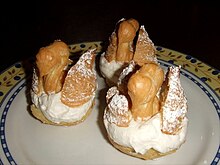Pâte à choux

Choux pastry swans
|
|
| Alternative names | Pâte à choux |
|---|---|
| Type | Pastry |
| Place of origin | France |
| Created by | Panterelli |
| Main ingredients | butter, flour, eggs, water |
| |
|
Choux pastry, or pâte à choux (pronounced [pɑt a ʃu]), is a light pastry dough used to make profiteroles, croquembouches, éclairs, French crullers, beignets, St. Honoré cake, quenelles, Parisian gnocchi, dumplings, gougères, chouquettes, craquelins and churros. It contains only butter, water, flour and eggs. Instead of a raising agent, it employs high moisture content to create steam during cooking to puff the pastry. The pastry is used in many European and European-derived cuisines.
According to some cookbooks, a chef by the name of Pantarelli or Pantanelli invented the dough in 1540, seven years after he left Florence with Catherine de' Medici and her court. He used the dough to make a gâteau and named it pâte à Pantanelli. Over time, the recipe of the dough evolved, and the name changed to pâte à popelin, which was used to make popelins, small cakes made in the shape of a woman's breasts. Then, Avice, a pâtissier in the eighteenth century, created what were then called choux buns. The name of the dough changed to pâte à choux, as Avice's buns resembled cabbages—choux in French.
From there, Antoine Carême made modifications to the recipe, resulting in the recipe most commonly used now for profiteroles.
The ingredients for choux pastry are butter, water, flour and eggs. Like Yorkshire Pudding or David Eyre's pancake, instead of a raising agent, it employs high moisture content to create steam during cooking to puff the pastry. The high moisture content is achieved by boiling the water and butter, then adding the flour. The mixture is cooked a few minutes longer, then cooled before adding enough eggs to achieve the desired consistency. The boiling step causes the starch in the flour to gel, allowing the incorporation of more water.
...
Wikipedia
